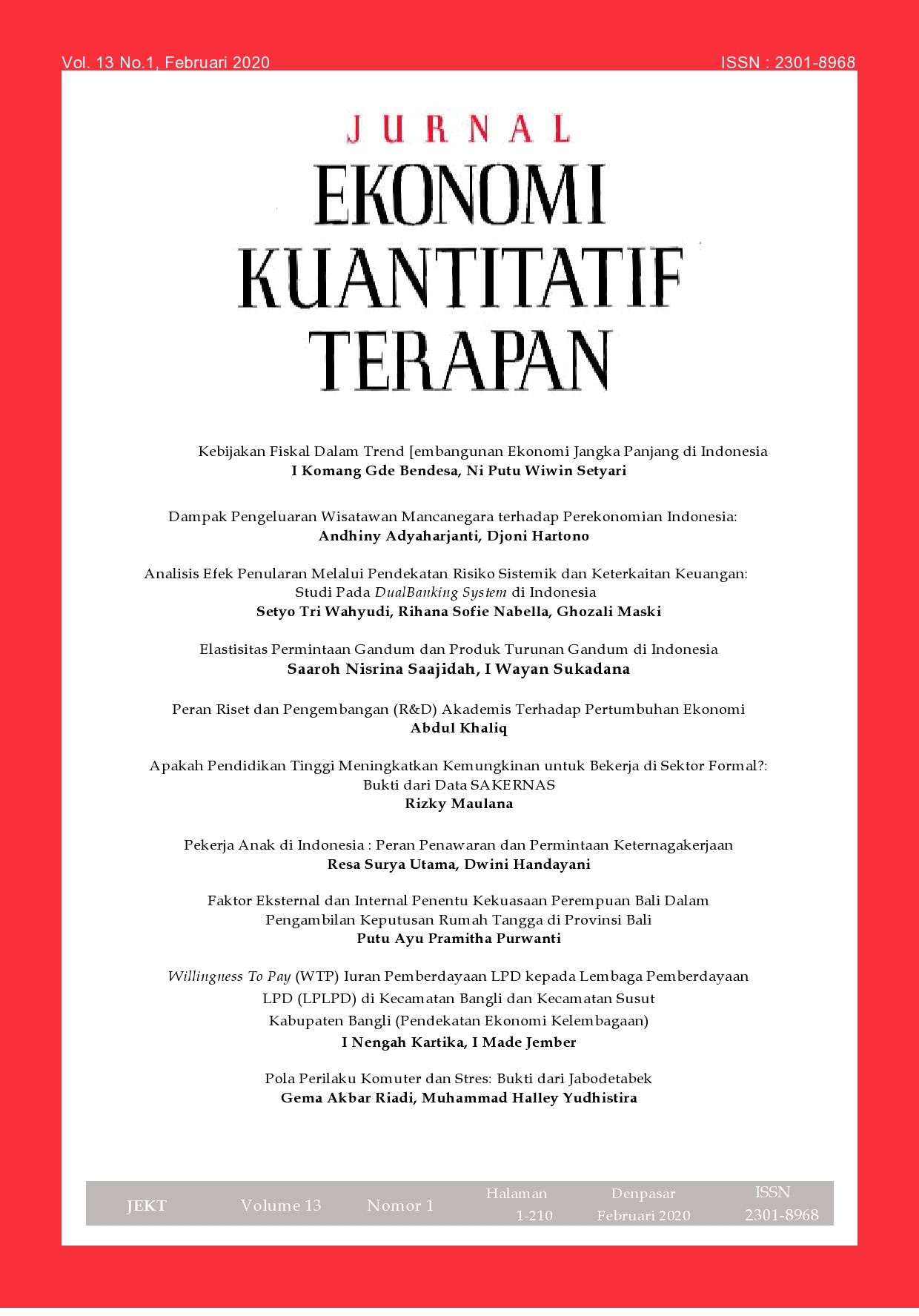Apakah Pendidikan Tinggi Meningkatkan Kemungkinan untuk Bekerja di Sektor Formal?
Bukti dari Data SAKERNAS
Abstract
This research aims to see whether tertiary education graduates are more likely to be employed in a formal sector than lower levels of education. Formal employment has a much higher wage rate than the informal sector. Students who go on to higher education have high expectations for their standard of living in the future, but there are still college graduates who work in the informal sector. To answer the purpose of this research, the writer uses probit regression. From these regressions, significant results were obtained. Higher education increases one's chances of being employed in the formal sector. Likewise, the sex and age variables. Male workers have a higher chance of being employed while the older labor forces have smaller chances of being employed in a formal sector.
Downloads
References
Badan Pusat Statistik, (2015-2018). Proporsi Lapangan Kerja Informal Sektor Non-Pertanian Menurut Kelompok Umur. [online] Available at: http://bit.ly/36XKeMP [Accesed 17 Dec. 2019].
Badan Pusat Statistik, (2015-2018). Rasio Angka Partisipasi Kasar (APK) Perempuan/Laki-Laki di Tingkat Perguruan Tinggi Menurut Kelompok Pengeluaran. [online] Available at: http://bit.ly/2sJuy12 [Accessed 19 Dec. 2019].
Badan Pusat Statistik, (2017). Rata-rata Upah/Gaji Bersih Sebulan (rupiah) Buruh/Karyawan/Pegawai Menurut Provinsi dan Lapangan Pekerjaan Utama. [online] Available at: http://bit.ly/2s3Z59T [Accessed 17 Dec. 2019].
Badan Pusat Statistik, (2018). Rata-rata Upah/Gaji Bersih Sebulan (rupiah) Buruh/Karyawan/Pegawai Menurut Provinsi dan Jenis Pekerjaan Utama. [online] Available at: http://bit.ly/2Shu78K [Accessed 17 Dec. 2019].
Badan Pusat Statistik, (2019). Rata-rata Upah/Gaji Bersih Sebulan (rupiah) Buruh/Karyawan/Pegawai Menurut Provinsi dan Jenis Pekerjaan Utama. [online] Available at: http://bit.ly/2Mdkkgl [Accessed 17 Dec. 2019].
Bairagya, I. (2012). Employment in India's informal sector: size, patterns, growth and determinants. Journal of the Asia Pacific Economy, 17(4), pp.593-615.
Bank, World. (2014) Indonesia’s Higher Education System: How Responsive is it to the Labor Market?
Bolang, P.D. and Osumanu, I.K. (2019). Formal sector workers’ participation in urban agriculture in Ghana: perspectives from the Wa Municipality. Heliyon, 5(8).
DIKTI, P. D. (2018). Statistik Pendidikan Tinggi.
Doğrul, H. (2012). Determinants of formal and informal sector employment in the urban areas of Turkey. International Journal of Social Sciences and Humanity Studies, 4(2), pp.217-231.
El Badaoui, E., Strobl, E. and Walsh, F. (2010). The formal sector wage premium and firm size. Journal of Development Economics, 91(1), pp.37-47.
Göbel, C. and Zwick, T. (2011). Age and Productivity: Sector Differences. De Economist, 160(1), pp.35-57.
Gujarati, D. (2003). Basic econometrics. 4th ed. Boston (Mass.): McGraw Hill.
Kahyalar, N., Fethi, S., Katircioglu, S. and Ouattara, B. (2018). Formal and informal sectors: is there any wage differential?. The Service Industries Journal, 38(11-12), pp.789-823.
Kementrian Keuangan, (2019). RAPBN 2019. [online] Available at: http://bit.ly/2PHydW0 [Accessed 19 Dec. 2019].
Ketenagakerjaan, D. and Ekonomi, A. (2002). Studi Profil Pekerja di Sektor Informal dan Arah Kebijakan ke Depan.
Nordman, C., Rakotomanana, F. and Roubaud, F. (2016). Informal versus Formal: A Panel Data Analysis of Earnings Gaps in Madagascar. World Development, 86, pp.1-17.
Pembangunan, K. E. K. (2009). Peran Sektor Informal Sebagai Katup Pengaman Masalah Ketenagakerjaan.
Singhari, S. and Madheswaran, S. (2017). Wage structure and wage differentials in formal and informal sectors in India. The Indian Journal of Labour Economics, 60(3), pp.389-414.
Takyi, B. and Gyimah, S. (2007). Matrilineal Family Ties and Marital Dissolution in Ghana. Journal of Family Issues, 28(5), pp.682-705.
Todaro, M. and Smith, S. (2015). Economic development. 12th ed. Harlow [u.a.]: Pearson.
Wubeshet, G. (2017). Gender-wise determinant of informal sector employment in Jigjiga town: A cross sectional study. Journal of Economics and International Finance, 9(7), pp.62-67.




















